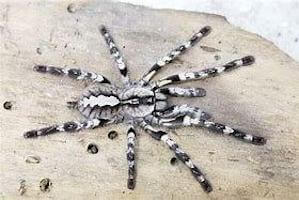India’s tiger tarantula spider – Poecliotheria regalis – was identified in India by one of the many British amateur naturalists serving in the subcontinent in the 19th century. Amongst them was Henry R P Carter who in 1858 had left Ireland for Madras to join the engineering staff of the Madras Railway. He was given charge of the construction of the Bangalore Branch which traverses the Saidanhr Pass. His fellow Madras engineer/naturalists were Henry West and a Mr Burrroughs-Strange. Carter contributed to the columns of The Asian and The Field. The fruits of their research are their specimens in jars of alcohol in London’s Natural History Museum.
 The tiger tarantula is a large black and white spider with lemon legs and is large enough to cover the palm of one’s hand, although this is not recommended, as the beast bites. It lives in trees, in a thatch roof or handy bungalow gutter. Its primary prey consists of various flying insects which it seizes in flight and paralyses. It moves rapidly and prefers flight to fight. A female can live up to 12 years; a male up to 5.
The tiger tarantula is a large black and white spider with lemon legs and is large enough to cover the palm of one’s hand, although this is not recommended, as the beast bites. It lives in trees, in a thatch roof or handy bungalow gutter. Its primary prey consists of various flying insects which it seizes in flight and paralyses. It moves rapidly and prefers flight to fight. A female can live up to 12 years; a male up to 5.
Other amateur spider-hunters in India at the time and into the 1930s were army officers, naval surgeons, telegraph operators, tea planters, chaplains, missionaries, box-wallahs and civil servants.
Chief Engineer Carter retired to England in 1894 and died at Chiswick in 1901, aged 67.
BACSA member Andrew Smith is an authority on the tiger tarantula.
Email andrewsmithbugs@yahoo.co.uk
With acknowledgements to Chowkidar of Spring 2004.
